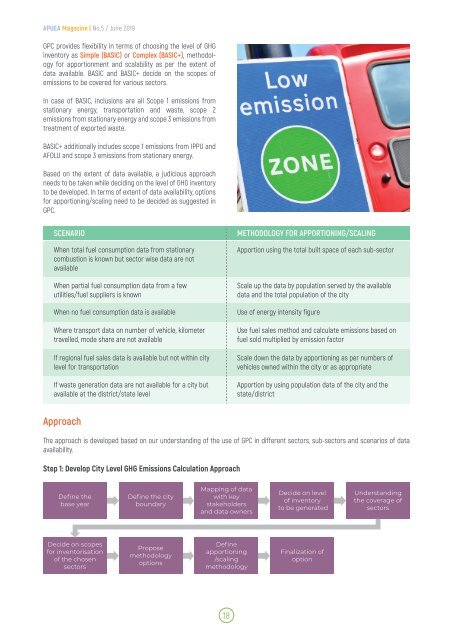APUEA Magazine-no.5 June 2019
Create successful ePaper yourself
Turn your PDF publications into a flip-book with our unique Google optimized e-Paper software.
<strong>APUEA</strong> <strong>Magazine</strong> | No.5 / <strong>June</strong> <strong>2019</strong><br />
GPC provides flexibility in terms of choosing the level of GHG<br />
inventory as Simple (BASIC) or Complex (BASIC+), methodology<br />
for apportionment and scalability as per the extent of<br />
data available. BASIC and BASIC+ decide on the scopes of<br />
emissions to be covered for various sectors.<br />
In case of BASIC, inclusions are all Scope 1 emissions from<br />
stationary energy, transportation and waste, scope 2<br />
emissions from stationary energy and scope 3 emissions from<br />
treatment of exported waste.<br />
BASIC+ additionally includes scope 1 emissions from IPPU and<br />
AFOLU and scope 3 emissions from stationary energy.<br />
Based on the extent of data available, a judicious approach<br />
needs to be taken while deciding on the level of GHG inventory<br />
to be developed. In terms of extent of data availability, options<br />
for apportioning/scaling need to be decided as suggested in<br />
GPC.<br />
SCENARIO<br />
When total fuel consumption data from stationary<br />
combustion is known but sector wise data are not<br />
available<br />
When partial fuel consumption data from a few<br />
utilities/fuel suppliers is known<br />
When no fuel consumption data is available<br />
Where transport data on number of vehicle, kilometer<br />
travelled, mode share are not available<br />
If regional fuel sales data is available but not within city<br />
level for transportation<br />
If waste generation data are not available for a city but<br />
available at the district/state level<br />
METHODOLOGY FOR APPORTIONING/SCALING<br />
Apportion using the total built space of each sub-sector<br />
Scale up the data by population served by the available<br />
data and the total population of the city<br />
Use of energy intensity figure<br />
Use fuel sales method and calculate emissions based on<br />
fuel sold multiplied by emission factor<br />
Scale down the data by apportioning as per numbers of<br />
vehicles owned within the city or as appropriate<br />
Apportion by using population data of the city and the<br />
state/district<br />
Approach<br />
The approach is developed based on our understanding of the use of GPC in different sectors, sub-sectors and scenarios of data<br />
availability.<br />
Step 1: Develop City Level GHG Emissions Calculation Approach<br />
Define the<br />
base year<br />
Define the city<br />
boundary<br />
Mapping of data<br />
with key<br />
stakeholders<br />
and data owners<br />
Decide on level<br />
of inventory<br />
to be generated<br />
Understanding<br />
the coverage of<br />
sectors<br />
Decide on scopes<br />
for inventorisation<br />
of the chosen<br />
sectors<br />
Propose<br />
methodology<br />
options<br />
Define<br />
apportioning<br />
/scaling<br />
methodology<br />
Finalization of<br />
option<br />
18




